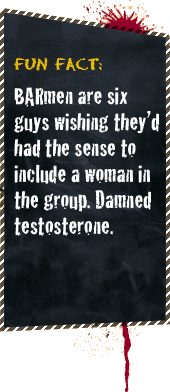Lesson Eight: Advanced Mixology
Chapter Nine: Orange You Happy You Can Make All These Drinks?
Brandy Crusta
This is really the daddy of them all; ostensibly, created in New Orleans by Santini in the 1850s, and while the use of orange Curacao connects it to these other new and wannabe classics, the early version was more notable for its sugared rim and lemon spiral poking down into the glass.
1 1/2 ounces VS Cognac
1/4 ounce maraschino liqueur
1/4 ounce orange Curaçao
1/4 ounce fresh lemon juice
1 dash Angostura bitters
Combine all ingredients in a mixing glass and shake well. Strain into a small cocktail glass with a lightly sugared rim, Garnish with small spiral of lemon around the inside rim of glass. Note: the 19th century cocktail glass had a narrow mouth and a wide swath of lemon peel would fit inside the rim of the glass.
Cosmopolitan
The modern classic has conquered the world; indeed, our own Dale DeGroff was given credit for inventing the Cosmo by New York Magazine. But he wasn’t the inventor even if he standardized the recipe and printed it on the cocktail menu at the Rainbow Room, where Madonna was spotted drinking one. That was all the rest of the world needed. The actual inventor is Cheryl Cook from South Beach in Miami, who recently surfaced to claim her invention.
1 1/2 ounces citrus vodka
3/4 ounce Cointreau
1/4 ounce fresh lime juice
1 ounce Ocean Spray Cranberry Juice Cocktail
Shake all ingredients with ice. Strain into a chilled cocktail glass. Garnish with an orange peel.
Between the Sheets
Another relative of the Side Car, but with a sexier name and better ingredients. There are other versions of this drink that omit Benedictine and use rum instead, but two base spirits can confuse the palate; this version is more interesting.
1 1/2 ounces VS Cognac brandy
1/2 oz. Benedictine
1/2 oz. Cointreau
3/4 oz. fresh lemon juice
Shake all ingredients with ice and strain into chilled cocktail glass. Garnish with a burnt orange peel.
Olympic
Frank Meier of Paris’s Ritz Bar is often credited with inventing the Sidecar; if he had, he would’ve taken credit for it in his book. Instead, he claimed the Sidecar’s sibling, the Olympic—a very nice drink, but no Sidecar. Still, it’s well worth making if you know where to get the oranges cheap.
2 ounces VSOP cognac
1 ounce Cointreau
1 ounce orange juice
Shake and strain into a chilled cocktail glass. (Optional: tip a couple drops of Peychaud’s bitters on top.)
Comet
This cute Sidecar by-blow was invented in 1952 by Eddie “King Cocktail” Clarke, head barman at the Albany Club in London, to celebrate BOAC’s new London–Johannesburg flight. This was the world’s first regularly scheduled passenger jet service. Van der Hum is a South African liqueur made from tangerines and herbs, and tastes sort of like a cross between Grand Marnier and Drambuie. Not bad.
2 ounces VSOP cognac or armagnac
1/2 ounce Van der Hum liqueur
1 ounce yellow grapefruit juice
1 dash Angostura bitters
Shake and strain into a chilled cocktail glass.
Sáicar
The Sáicar (according to our Cassell’s Spanish-English Dictionary, that’s Spanish for “sidecar,” although actual Spaniards have told me that the dictionary’s talking through its hat) incestuously splits the difference between the Margarita and the Sidecar and is none the worse for it.
1 lemon wedge
Large-grained sugar (such as “Sugar in the Raw”)
Kosher or margarita salt
1 1/4 ounces Spanish brandy
1 ounce reposado tequila made from 100 percent agave
1 ounce Cointreau
1/2 ounce lime juice
1/2 ounce lemon juice
Before chilling your cocktail glass, moisten its outside rim to a depth of 1/2 inch with the lemon wedge and then roll the rim in a mixture of two parts sugar to one part salt. Shake the brandy, tequila, Cointreau, and citrus juices and strain into the chilled glass.
Gotham
Gotham magazine is a ritzy New York monthly aimed strictly at the haves. Wondrich came up with this drink for its debut issue in the course of his duties as cocktail editor. His mandate was to create with something swank and sophisticated, yet not too difficult to knock together—the editor wanted something that would replace the Cosmo. He won’t admit to failure, but Wondrich certainly concedes that the schedule has slipped a tad.
2 ounces VSOP cognac
1 ounce French (dry) vermouth
1/2 ounce crème de cassis
1/2 teaspoon lemon juice
To finish: lemon peel
Stir and strain into a chilled cocktail glass; twist lemon peel over the top.
Avec
Whenever they need a French word in a Pepé Le Pew cartoon, they use avec (“with,” for those of you who were out smoking cigarettes on a bathroom pass that day). It’s nonsensical, but it’s amusing—kinda like this Sidecar variant.
1 ounce imported kirschwasser
1 ounce cognac
1 ounce white Lillet
1 ounce orange juice
2 dashes Angostura bitters
To finish: orange peel
Shake and strain into a chilled cocktail glass; twist orange peel over the top.
Blood and Sand
At first glance, this most unusual Scotch cocktail seemed a god-awful mix. But the recipe, one of the very few classic Scotch cocktails, is a rather delightful mix so don’t judge it without tasting it.
3/4 ounce blended scotch
3/4 ounce Cherry Heering
3/4 ounce Italian sweet vermouth
3/4 ounce orange juice
Shake and strain into a cocktail glass. Garnish with an orange peel.
Ward 8
Ryan Demonstrates How To Make a Ward 8
Ward 8
In mixing glass;
Add 2 oz Rye Whiskey
1/2 oz Orange Juice
1/2 oz Lemon Juice
1/2 oz Grenadine
Add Ice
Shake hard, shake long, shake well
Strain and serve in a collins glass or cocktail glass
Garnish with an orange and maraschino cherry
Recipes reproduced from “Killer Cocktails” by David Wondrich


